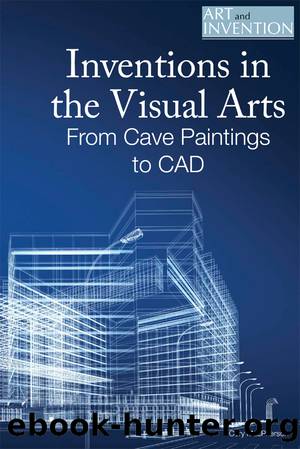Inventions in the Visual Arts by MacPherson Cory;

Author:MacPherson, Cory; [MacPherson, Cory]
Language: eng
Format: epub
Publisher: Cavendish Square Publishing LLC
The CAMERA THAT CAPTURED the WORLD: KODAK
In 1877, a young man named George Eastman was planning his future in real estate. He worked at the Rochester Savings Bank in Rochester, New York, as a junior bookkeeper and had saved enough money to travel to Hispaniola to begin his career. Eastmanâs father was the founder of a business school; the entrepreneurial spirit seemed to run in the family blood. As a boy, Eastmanâs early education took place on the farm where he grew up. Though he attended school when he was eight years old until he was fifteen, he was mostly self-taught, led by his own natural curiosity. A future in land speculation looked promising, but Eastman never made it to Hispaniola. Something much bigger took place: he bought his first camera.
From this point on, he became obsessed with photography, and he initiated an apprenticeship under two local photographers. He resumed his self-directed education by reading the British Journal of Photography on a regular basis. Savvy to the contemporary technology in his field, Eastman began to experiment with the plates and chemicals that were used to develop photographs, which had not changed much since Daguerre. In order to advance beyond capturing portraits and landscapes, photographers needed a camera that could capture moving objects and a development process that did not require a âportableâ darkroom. In an age of cell phone cameras, the term portable darkroom sounds ridiculousâitâs difficult to imagine a time when cameras were too big to fit inside your back pocket or too heavy hang around your neck on an adjustable strap. This is because, in 1884, Eastman introduced dry film, which replaced the chemically treated plates that were commonly used up until this time. The dry film was stored in a roll that protected the captured images from light exposure. Roll film technology eliminated the need for photographers to develop their images on-site; in fact, Kodakâs mail-in developing service freed them from the process completely.
DOCUMENTATION OF EPHEMERAL ART
Andy Goldsworthy, a contemporary visual artist, creates site-specific art that is too ephemeral, or short lived, and too geographically remote to be viewed by the general public. In his work, he might weave branches together in a forest to create a dome, place red autumn leaves on the ground in a circular pattern, or even use icicles as his medium, linking them together to form an arch or spiral. The role of both nature and time in art are clearly expressed in a series of what Goldsworthy calls ârain shadows.â He described the process of making a rain shadow in an NPR interview: âWhen it rains, I lay down or I find a surface quickly that I think will produce a good rain shadow, and I lay there, and when itâs wet enough, I get up and there is left meâmy imprint, my shadow.â But heâs not making the rain shadows for the sake of the statement they make about the ephemerality of art. Above all, Goldsworthy wants his artistic process to deepen his understanding of the world.
Download
This site does not store any files on its server. We only index and link to content provided by other sites. Please contact the content providers to delete copyright contents if any and email us, we'll remove relevant links or contents immediately.
Harry Potter: A Journey Through a History of Magic by British Library(368)
The Science of Philip Pullman's His Dark Materials by Mary Gribbin(343)
The Basics of Organic Chemistry by Clowes Martin;(342)
Harry Potter and the Sorcerer's Stone: SparkNotes Literature Guide by SparkNotes(305)
Flowers in the Gutter by K. R. Gaddy(274)
Braiding Sweetgrass for Young Adults by Robin Wall Kimmerer(266)
Super Simple Chemistry by D.K. Publishing(262)
Summary of the Selfish Gene by Readtrepreneur Publishing(259)
Exam Success in Geography for IGCSE & O Level by Unknown(258)
JavaScript Coding for Teens: A Beginner's Guide to Developing Websites and Games by Yueh Andrew(253)
Dark days in Salem: the witchcraft trials by Deborah Kent(246)
The Python Audio Cookbook;Recipes for Audio Scripting with Python by Alexandros Drymonitis(240)
Analysis and Linear Algebra for Finance: Part II by Bookboon.com(236)
Key Immigration Laws by Kathryn Ohnaka(230)
Cracking the AP Economics Macro & Micro Exams, 2017 Edition by Princeton Review(225)
Solutions for a Cleaner, Greener Planet: Environmental Chemistry by Marc Zimmer(216)
The Science of Fashion by Julie Danneberg;(212)
Reverse Engineering For Everyone! by mytechnotalent(204)
Cracking the AP Psychology Exam, 2017 Edition by Princeton Review(200)
